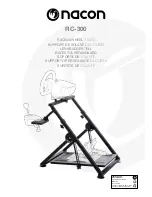
12
GENERAL RULES FOR A CORRECT
OVERHAULING AND MAINTENANCE
1. Where specified, assemble and disassemble
the shock absorption system only using the
LARM or MARZOCCHI special tools, as shown
in the table below.
2. On reassembling the suspension system, al-
ways use new seals.
3. If two screws are close one to the other, always
tighten using a 1-2-1 sequence. In short, screw
the first screw just up to the point it is well
tightened, then tighten the second screw and
then go back to the first one and screw it tighter.
4. Clean all metal parts with a special, preferably
biodegradable solvent, such as trichloroethane
or trichloroethylene.
5. Before reassembling, lubricate all parts in con-
tact with each other using silicone fat spray.
6. Always grease the conic seal rings before reas-
sembling.
7. Use wrenches with metric size only. Wrenches
with inch size might damage the fastening de-
vices even when their size is similar to that of the
wrenches in metric size.
REGOLE GENERALI
1. Laddove specificato, assemblare e smontare il
sistema di sospensione usando soltanto gli
speciali attrezzi MARZOCCHI o LARM di cui
viene fornita una descrizione nella tabella ripor-
tata di seguito.
2. Al momento di riassemblare il sistema di so-
spensione, usare sempre guarnizioni nuove.
3. Nel caso in cui due viti siano vicine l’una all’altra,
seguire sempre una sequenza 1-2-1 per fissar-
le. In altri termini, stringere la prima vite soltanto
fino al punto in cui essa risulta essere ben
serrata, passare quindi alla seconda e solo
successivamente tornare alla prima vite per
assicurarsi di serrarla più saldamente.
4. Pulire tutte le parti metalliche utilizzando un
solvente specifico, preferibilmente biodegrada-
bile, come tricloroetano oppure trielina.
5. Prima di riassemblare gli elementi, lubrificare
tutte le parti in contatto l’una con l’altra, usando
grasso spry al silicone oppure olio specifico per
guarnizioni di tenuta.
6. Ingrassare sempre le guarnizioni con labbro per
tenuta d’olio prima di procedere al riassemblag-
gio.
7. Usare soltanto chiavi metriche. Le chiavi in
pollici potrebbero danneggiare i dispositivi di
fissaggio anche nel caso in cui la rispettiva
dimensione si avvicinasse a quella delle chiavi
metriche.












































